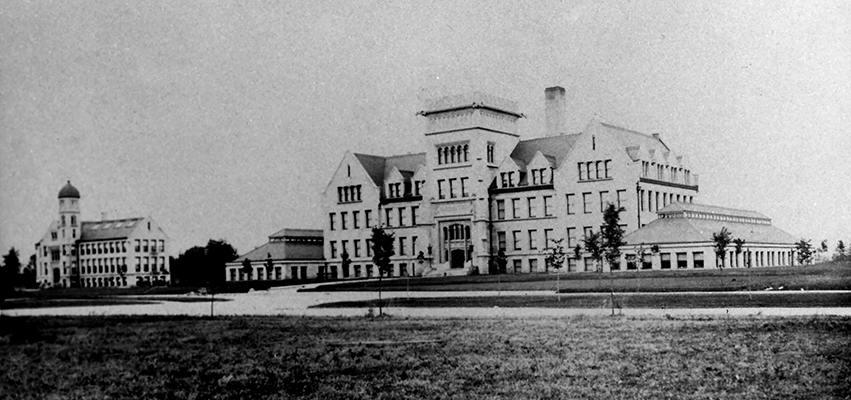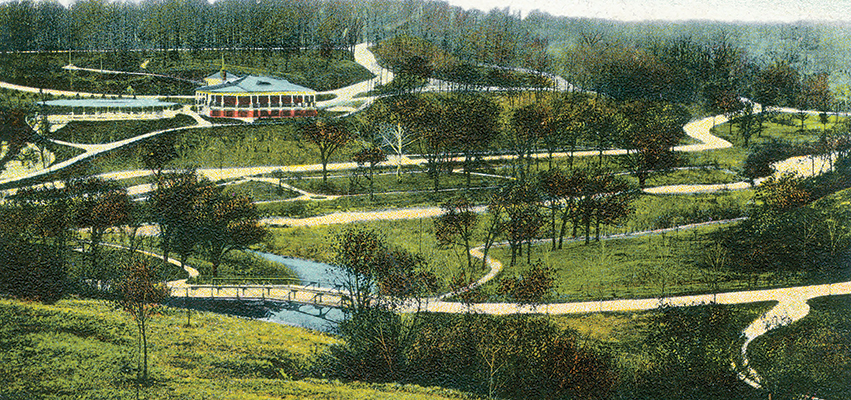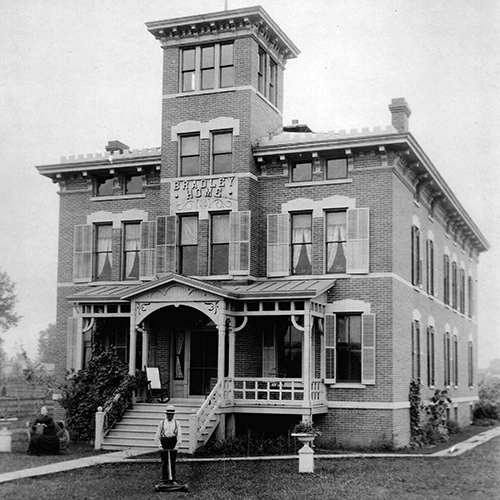Reflections on Lydia Moss Bradley’s remarkable life as a pioneer, businesswoman, farmer and philanthropist
If historians created a list of the people who shaped Peoria, Lydia Moss Bradley would certainly be near the top. In the mid-1800s, she and her husband Tobias were the city’s “power couple.” Numerous Peoria businesses—including a distillery, a flour mill and a bank—thrived under Tobias’ guidance, while Lydia, widely known as the founder of Bradley University, touched nearly every facet of her community. After her husband’s death, she continued on her own as an entrepreneur and philanthropist—one of the most successful in American history.
A small, industrious woman with energy, pluck and practicality, Lydia was a smart, resourceful businesswoman with a kind and giving spirit. A wise investor, her philosophy with both financial investments and philanthropies was to leave the world a better place than she found it. Fortunately for central Illinois, her world became Peoria, and the entire region still benefits from the many ways she invested her dollars—and her sense.
Success Amidst Tragedy
Lydia Moss was born in Vevay, Indiana, on July 31, 1816 to Zeally and Jenny Glasscock Moss. He was a Revolutionary War veteran; she was from one of the first families to come to the United States. Two hundred years later, Peoria continues to be shaped by their daughter’s vision, entrepreneurship and philanthropy. In addition to Bradley University, OSF Saint Francis Medical Center, the Peoria Park District and Children’s Home Association of Illinois can all trace their founding roots back to her.
Lydia married Tobias Bradley in 1837, and the couple moved to Peoria 10 years later. As they considered where they would settle, Lydia made it clear she did not want to live in a slave-holding state. They ultimately chose Peoria, where Lydia’s brother, William Moss, a steamboat captain, had settled in the early 1830s. Using the profits Lydia earned from selling land she owned in Indiana, the couple purchased land in Peoria that encompassed the future campus of Bradley University, the neighborhood now known as The Uplands, and beyond. They lived in a tastefully decorated home at 802 West Moss Avenue, which still stands today.
With her strong abolitionist views, Mrs. Bradley was believed to be an agent for the Underground Railroad, helping escaped slaves on their way to freedom in the northern states or Canada. One of these safe houses was on the south side of Peoria, where the Bradleys owned several properties.
Though the couple thrived financially, they faced a series of tragedies with the deaths of all six of their children. In 1867, three years after their daughter Laura’s death at age 14, Tobias was killed in a horse-and-buggy accident. Suddenly, Mrs. Bradley was left with an estate valued at $500,000—at a time when women had no voting rights and were not considered equals in the business world. But the same entrepreneurial spirit she displayed as a teenager—when she sold a horse her father had given her to buy some land—surfaced once again as she faced the second half of her life: alone, yet equipped with the financial wherewithal, generosity and business acumen needed to make an indelible mark on Peoria.

Founded by Lydia Moss Bradley, Bradley Polytechnic Institute opened its doors on October 4, 1897 in two buildings: Bradley Hall, right, and Horology Hall, left. Bradley became a four-year college in 1920 and a full university with graduate programs in 1946, when it was renamed Bradley University.
Hands-On In Business
Tobias Bradley was the founder and first president of First National Bank of Peoria, and his widow inherited stock in the bank. Soon, Lydia Moss Bradley became the first woman to serve on the board of a national bank in the state of Illinois—and possibly the entire country. She also managed rentals for several properties in Peoria and began to subdivide her land. To increase the value of the property before selling, she personally planted ash and elm trees along Bradley Avenue.
W.W. Hammond, employed by Mrs. Bradley in 1885, was her business manager for nearly a quarter of a century. He describes her this way in his “Review of Mrs. Bradley’s Life and Business”:
“Founder of the [Bradley Polytechnic] Institute, the Mother of the Bradley Home, the donor of Bradley Park and of Bradley Memorial Church, a banker, farmer, real estate dealer, born of very moderate circumstances, a generous giver all her life, the possessor in her old age of millions honestly acquired, a faithful wife and mother, industrious and economical yet always neighborly, kind-hearted and sympathetic; unassuming, modest and retiring; untouched by the vanity of riches…”
Hammond and Mrs. Bradley made an unstoppable duo. Coupling her imagination and drive with his business sense and loyalty, Mrs. Bradley’s estate doubled again to $2 million between 1885 and 1897, and the two met daily to discuss business transactions and potential ventures. Hammond would bring to her the money he collected the previous day, and she would place it in a cigar box which she kept in a secret place in her house until the funds could be deposited in a bank. She was very hands-on with her business dealings, never making an investment without a full report.

Mrs. Bradley donated 100 acres to the City of Peoria to establish Laura Bradley Park in memory of her longest-surviving daughter. In 1891, she offered additional land if the city would establish a park board to levy taxes and improve the property, and soon, the Peoria Pleasure Driveway and Park District was established.
The Social Entrepreneur
Lydia Moss Bradley sought out innovative ways to make money while benefiting others at the same time. She was involved with several land reclamation efforts, always leaving the land in better condition than she found it. For example, she was instrumental in promoting the drainage of the Manito Marsh, where she held land. That land, however, was farmed with poor results, and an analysis revealed the soil was rich but lacked potash. Upon learning that Kainit, a potash salt from Germany, had been useful at other drained marsh sites, Mrs. Bradley ordered a carload and spread it across 100 acres. Soon her plan was adopted by the entire neighborhood, and land that once sold for $10 an acre was selling for $140 an acre. In another ingenious move, she once brought in 1,800 Angora goats to clear her land in Fulton, Mason and Peoria counties.
Just as her business acumen always included an eye for improvement, so did her philanthropies. She donated 100 acres to the City of Peoria to establish Laura Bradley Park, and in 1891, she offered to give even more land if the city would establish a park board to levy taxes and improve the property. Soon, the Peoria Pleasure Driveway and Park District—the first chartered in Illinois—was established. She financed the building of the Bradley Home for Aged Women, and when funds were insufficient to keep its doors open, she paid for the residents’ entry to the newly-built Proctor Home. After Bradley Polytechnic Institute opened, the former home was used as a dormitory.
In 1875, when the Home of the Friendless—known today as Children’s Home Association of Illinois—needed a place for children, Mrs. Bradley offered a home rent-free for many years. She paid the final $30,000 on the mortgage for the Universalist Church, known for a time as Bradley Memorial Church, and when bond sales for the Grand Opera House on Hamilton Boulevard were slow, she invested $15,000 to ensure a successful fund drive.
OSF Saint Francis Medical Center can also trace its first days to Mrs. Bradley. She offered property on the East Bluff to the Sisters of the Order of St. Francis, who had come to Peoria to establish a hospital. Known briefly as Bradley Hospital, the donation was later refunded and the name changed to St. Francis Hospital.
An Enduring Legacy
As Mrs. Bradley helped build these facilities—so vital to Peoria’s future—she never forgot the conversations she and her husband had about building a fitting tribute to their children. Along the way, she was inspired by a visit to Rose Polytechnic Institute in Indiana, appreciating the practical education its students received. Her idea for a coeducational, non-sectarian school began to take shape, and when she had the opportunity to purchase the Parsons School of Horology in LaPorte, Indiana, and move its students, faculty and equipment to Peoria, that’s exactly what she did.
But her vision didn’t stop there. She began talks with Dr. William Rainey Harper, president of the University of Chicago, who convinced her to proceed with a school during her lifetime, rather than bequeath the land and funds to build a school after her death. Mrs. Bradley channeled her love and generosity into the founding of Bradley Polytechnic Institute in 1897.
The Institute was more than a center for higher learning in Mrs. Bradley’s eyes: it was her foster child. She nurtured it attentively through its infancy, establishing a firm foundation for today’s Bradley University. Her goal was to create a school in which young adults could learn to lead purposeful lives—an initiative that continues to bear fruit more than a century after her death.
Lydia Moss Bradley passed away on January 16, 1908, a role model for the ages. Without her wisdom, generosity and leadership, the Peoria area would look far differently today. Through Bradley University and its alumni, her influence has become a global one—an enduring legacy built right here in Peoria. a&s
This year, Bradley University celebrates the 200th birthday of its founder, Lydia Moss Bradley. For a complete list of events, visit bradley.edu/sites/lmb200.


